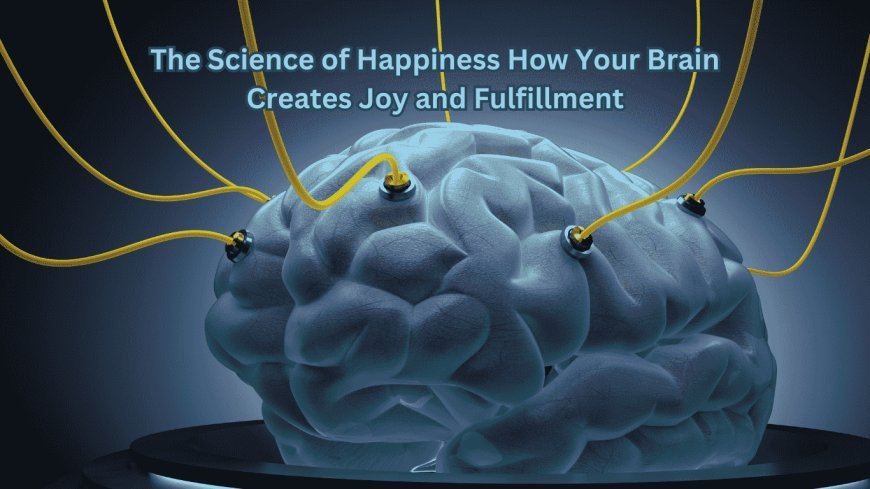The Science of Happiness: How Your Brain Creates Joy and Fulfillment
Explore the fascinating science of happiness and how your brain works to create joy and fulfillment. Understand the role of neurotransmitters, emotions, and practices that lead to lasting happiness.

Introduction
Everyone wants happiness. We pursue it via relationships, accomplishments, travel, and things. Have you pondered how your brain experiences happiness? Your brain creates pleasure, satisfaction, and fulfillment that make life meaningful. How?
This blog article delves into the science of happiness, studying how our brain produces pleasant feelings and how we may use that knowledge to live happier, more fulfilling lives. Neurotransmitters and neuroplasticity—let's discover how our brains create bliss.
What is happiness? A Quick Overview
Happiness involves emotional, psychological, and social components and is not transient. The definition of happiness generally includes:
- Happiness, love, and enthusiasm
- Life satisfaction, meaning, and purpose
- Fulfillment and success
After much debate, psychologists agree that pleasure is a mix of brain processes, environmental circumstances, and human decisions.
How Your Brain Creates Happiness: The Role of Neurotransmitters
Happiness stems from brain chemistry. Several substances or neurotransmitters affect our delight and pleasure. Look at the big players:
1. Dopamine: The "Feel-Good" Chemical
The “pleasure” neurotransmitter is dopamine. It's released when we enjoy a meal, accomplish a goal, or get praise. Dopamine makes us feel happy and encourages us to repeat the acts that earned them.
Key points about dopamine:
- It is released when we enjoy or anticipate a reward.
- Motivation, attention, and learning are involved.
- Chronic low dopamine levels may cause emptiness and purposelessness.
2. Serotonin: The Mood Stabilizer
Another happy neurotransmitter is serotonin. It regulates mood, sleep, hunger, and social behavior. Contentment, calm, and emotional stability are linked to serotonin equilibrium.
Key points about serotonin:
- The discharge occurs when we feel accomplished, connected, or relaxed.
- Depression and anxiety may result from low serotonin.
- Serotonin is increased by exercise, meditation, and sunshine.
3. Oxytocin: The "Love" Hormone
It's termed the "love hormone" because oxytocin helps individuals bond. When hugged or aiding someone, it's released.
Key points about oxytocin:
- Bonding, empathy, and trust are involved.
- Kindness, personal connections, and caressing animals increase oxytocin.
- It may alleviate tension and increase safety and comfort.
4. Endorphins: Natural Painkillers and Mood Boosters
When you exercise, laugh, or eat chocolate, your brain releases endorphins, which relieve pain. They relieve tension and discomfort, causing bliss.
Key points about endorphins:
- They are released during exercise, laughing, and physical activity.
- Pain and tension may be reduced by endorphins.
- They induce a "runner's high."
How Your Brain’s Structure Affects Happiness
The physical structure of your brain affects your pleasure beyond chemicals. The following brain areas affect happiness:
1. The Prefrontal Cortex: The Decision-Maker
The PFC controls higher-level thinking, decision-making, and emotion. It aids decision-making and emotional control. Mindfulness and meditation improve the PFC, improving emotional regulation and mood.
2. The Limbic System: The Emotional Center
Your brain's limbic system processes emotions. It regulates fear, anger, and pleasure. The limbic system's amygdala controls emotion processing. Happiness is more probable with a healthy limbic system.
3. The Hippocampus: Memory and Learning
Hippocampal neurons build memories and learn from prior experiences. It helps us remember happy memories and make happy decisions. Studies demonstrate that enlarged hippocampuses improve well-being.
The Power of Positive Psychology: Training Your Brain for Happiness
Positive psychology study reveals that you can educate your brain to be happier, even if your brain's chemistry and structure determine happiness. Techniques supported by science:
1. Gratitude Practices
One of the best ways to improve happiness is gratitude. Studies suggest that individuals who consistently express gratitude—by writing down their thanks or orally expressing great experiences—are happier and more satisfied.
2. Mindfulness Meditation
In mindfulness meditation, you focus on the present without judgment. Regular mindfulness meditation may enhance brain gray matter in emotional control and happiness regions, according to research.
3. Exercise
Physical exercise boosts mood by releasing endorphins and serotonin. Exercise is a great method to release happy chemicals in the brain, whether it's a brisk stroll, yoga, or the gym.
4. Social Connections
Time with family, friends, and meaningful social connections boosts oxytocin and serotonin. A solid support system boosts happiness and fulfillment.
5. Pursuing Meaningful Goals
Goals that reflect your values provide more satisfaction. It's about doing things that give your life significance, whether it's work, personal projects, or creativity.
The Role of Neuroplasticity in Happiness
Neuroplasticity is the brain's capacity to generate new neural connections throughout life. This suggests we can alter our brain circuitry to boost happiness. We may "rewire" our brains to be happy by practicing gratitude, compassion, and mindfulness.
Happiness is something we can grow over time, according to neuroplasticity. As we practice good behaviors, our happy brain connections strengthen.
How to Create a Happy Brain: Simple Habits for Everyday Joy
After discussing the science of happiness, we'll discuss how to apply it. Simple practices may make your brain happier:
- Morning gratitude: Reflect on what you're grateful for. This simple activity may improve your attitude all day.
- Exercise daily: Aim for 30 minutes of moderate exercise. Walking every day may boost your happiness, even to a moderate level.
- Practice mindfulness: Practice mindfulness every day by meditating, deep breathing, or being present.
- Build good relationships: hang out with folks that encourage you. Invest in fulfilling connections.
- Paint, dance, or volunteer—do anything that makes you feel alive and useful.

 shofiul
shofiul 





